BIG NAZI PARTY RALLY IN NUREMBERG
Nuremberg, Germany · September 10, 1935
On this date in 1935 the Nazis convened their annual party congress in Nuremberg completely fixated on the charismatic savior-figure Adolf Hitler, Germany’s chancellor since January 1933. The 1935 “Rally of Freedom” (Reichsparteitag der Freiheit) touted Hitler’s wildly popular reintegration of the Saar region—formerly a League of Nations mandate—into Germany and the partial lifting of the hated Versailles Treaty of 1919 that constrained Germany’s room to maneuver militarily. But the real news was made by Reichstag members whose strings, in Hitler’s hands, drew them to Nuremberg. On September 15 the puppet parliament passed the Nuremberg Laws (Nürnberger Gesetze). Previous laws had allowed some Jews to escape from the Nazis’ discrimination aimed at them. But with passage of the Nuremberg Laws, there was no more wiggle room. A German Jew was classified as Jude based on the person’s descent from three or four Jewish grandparents, a Mischling (crossbreed) if descended from one or two. Evading discrimination by converting to Christianity was now rendered impossible. Thus, one Nuremberg law forbade marriage or extramarital relations between Jews and “nationals of German or kindred blood,” and the employment of “German” females under forty-five in Jewish households. A second law stripped German citizenship from persons not considered of German blood and introduced a new distinction between “Reich citizens” (Reichsbürger) and “Reich nationals” (Staatsangehörige). The effect of these laws led straight to Kristallnacht (“Night of Broken Glass”), when carefully orchestrated anti-Jewish violence “erupted” throughout the Reich. Starting on November 9, 1938, and for the next 48 hours, Nazi rioters burned or damaged nearly every synagogue in Germany and ransacked and smashed the windows of more than 7,500 businesses, community centers, and homes. An estimated 400 Jews were killed and 20,000 to 30,000 Jews between the ages of 16 and 60 were imprisoned or taken away to German concentration camps in the November pogrom. Over 115,000 more fled their homelands in Germany and Austria. Heaping insult on injury, the Nazi government demanded that Jews sweep up the mess and pay six million Reichsmarks ($1.44 million) to the German government to cover the cost of insurance claims for property damage.
![]()
Kristallnacht, November 9–10, 1938: Violent Turning Point in Nazi Germany’s Assault on Jews
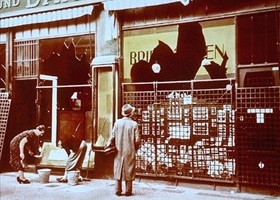 | 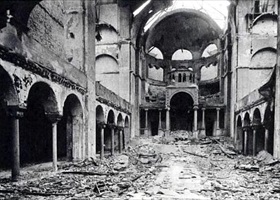 |
Left: Example of damage directed at Jewish businesses during Kristallnacht (literally “crystal night”), alluding to the enormous number of glass windows broken throughout the night, mostly in synagogues and Jewish-owned shops. With Kristallnacht the Nazis achieved three of their goals: confiscation of Jewish property by local branches of the Nazi Party to help finance the military buildup to war; increased separation, marginalization, and isolation of German Jews (in certain neighborhoods Jews were required to sell their homes at huge losses and move to other neighborhoods); and most importantly, the move from the anti-Semitic policy of discrimination to one of ethnic cleansing, which continued in the Third Reich and conquered territories until the end of World War II.
![]()
Right: Interior of Berlin’s Fasenenstrasse Synagogue, constructed between 1910 and 1912 in the affluent neighborhood of Charlottenburg off Kurfürstendamm, after it was set on fire during Kristallnacht on the morning of November 10, 1938 (perhaps not ironically, Martin Luther’s birthday). In Berlin 9 out of 17 synagogues were torched; in Vienna, the Austrian capital, 95. In all, over 1,000 synagogues were vandalized or destroyed.
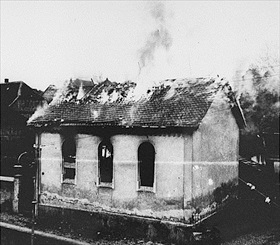 | 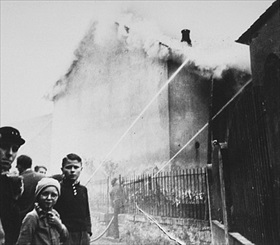 |
Left: Not even the smallest towns in Germany escaped the Nazis’ anti-Jewish pogrom. In this photo, a small synagogue in Ober Ramstadt (Hessen, Germany), roughly 18 miles south of Frankfurt am Main, burns on Kristallnacht.
![]()
Right: As the Ober Ramstadt synagogue burned, local residents watched firefighters instead save a nearby house. In some German cities, such as Cologne, police handed out axes and other tools of destruction to troublemakers in the mob, supplying them with a list of names and addresses of Jewish properties for them to destroy. The mobs cut fire hoses when firefighters directed water onto Jewish properties.
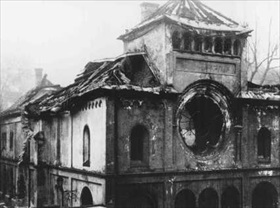 | 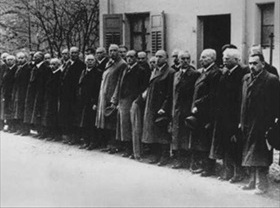 |
Left: Munich’s Herzog Rudolfstrasse synagogue off Maximillianstrasse. By midnight, November 9, 1938, attacks on Jewish businesses, homes, and synagogues were occurring all over Germany and Austria. Mobs roamed the streets shouting, “Beat the Jews to death!” In Munich, the first synagogues started burning at midnight. In Berlin, Kristallnacht was delayed till 2 a.m. on November 10 so that the police would have time to prepare. They identified Jewish properties that would be destroyed and set up roadblocks to keep traffic away from those areas. Police were instructed not to interfere with the rioters.
![]()
Right: As the looting and destruction wound down on November 10, 1938, the arrests began. Jewish men of all ages were rounded up and marched through the streets as some of their German neighbors hurled insults at them. In this photograph, Jews arrested after Kristallnacht await deportation to Dachau concentration camp north of Munich. Others were sent to Buchenwald and Sachsenhausen. The treatment of camp inmates was brutal, but most were released within three months on the condition they leave Germany.
Kristallnacht, November 9–10, 1938: Holocaust Start Date
![]()

 History buffs, there is good news! The Daily Chronicles of World War II is now available as an ebook for $4.99 on Amazon.com. Containing a year’s worth of dated entries from this website, the ebook brings the story of this tumultuous era to life in a compelling, authoritative, and succinct manner. Featuring inventive navigation aids, the ebook enables readers to instantly move forward or backward by month and date to different dated entries. Simple and elegant! Click
History buffs, there is good news! The Daily Chronicles of World War II is now available as an ebook for $4.99 on Amazon.com. Containing a year’s worth of dated entries from this website, the ebook brings the story of this tumultuous era to life in a compelling, authoritative, and succinct manner. Featuring inventive navigation aids, the ebook enables readers to instantly move forward or backward by month and date to different dated entries. Simple and elegant! Click 











